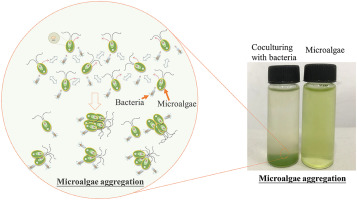Environmental Pollution ( IF 7.6 ) Pub Date : 2020-01-07 , DOI: 10.1016/j.envpol.2020.113924 Ranran Zhao 1 , Guowei Chen 2 , Li Liu 1 , Wei Zhang 3 , Yifei Sun 4 , Baoguo Li 4 , Gang Wang 4

|
Microalgal aggregation is a key to many ecosystem functions in aquatic environments. Yet mechanistic understanding of microalgae aggregation, especially the interactions with ubiquitous bacteria populations, remains elusive. We reported an experimental study illustrating how the emerging bacterial populations interacted with a model microalga (Chlamydomonas microsphaera) cells and the consequent aggregation patterns. Results showed that the emergence of bacterial populations significantly stimulated C. microsphaera aggregation. Both bacterial and C. microsphaera motilities were remarkably excited upon coculturing, with the mean cell velocity being up to 2.67 and 1.80 times of those of separate bacterial and C. microsphaera cultures, respectively. The stimulated bacterial and C. microsphaera cell velocity upon coculturing would likely provide a mechanism for enhanced probability of cell-cell collisions that led to amplified aggregation of C. microsphaera population. Correlation analysis revealed that bacterial resource foraging (for polysaccharides) was likely a candidate mechanism for stimulated cell motility in an organic carbon source-limited environment, whereby C. microsphaera-derived polysaccharides serve as the sole organic carbon source for heterotrophic bacteria which in turns facilitates bacteria-C. microsphaera aggregation. Additional analysis showed that bacterial populations capable of successive decomposing algal-derived organic matters dominated the cocultures, with the top five abundant genera of Brevundimonas (24.78%), Shinella (17.94%), Sphingopyxis (11.62%), Dongia (5.82%) and Hyphomicrobium (5.45%). These findings provide new insights into full understanding of microalgae-bacteria interactions and consequent microbial aggregation characteristics in aquatic ecosystems.
中文翻译:

在有机碳源限制的水生环境中,细菌觅食促进了小衣藻的聚集。
微藻聚集是水生环境中许多生态系统功能的关键。然而,对微藻聚集的机械理解,尤其是与无处不在的细菌种群之间的相互作用,仍然难以捉摸。我们报道了一项实验研究,阐明了新兴细菌种群如何与模型微藻(衣藻)相互作用以及随后的聚集模式。结果表明,细菌种群的出现显着刺激了微球藻的聚集。共培养时显着激发了细菌和微球藻的移动,平均细胞速度分别是分离的细菌和微球藻的平均细胞速度的2.67和1.80倍文化。共培养时刺激的细菌和微球藻的细胞速度可能会提供增加细胞-细胞碰撞概率的机制,从而导致微球藻种群的聚集聚集。相关分析表明,细菌资源的觅食(针对多糖)可能是在有机碳源受限的环境中刺激细胞运动的候选机制,因此,微球藻来源的多糖充当异养细菌的唯一有机碳源,反过来有助于细菌-微球藻聚合。进一步的分析表明,能够连续分解藻类有机物的细菌种群在共培养中占主导地位,其中Brevundimonas(54.78%),Shinella(17.94%),Sphingopyxis(11.62%),Dongia(5.82%)和5个最丰富的属。micro(5.45%)。这些发现为全面了解水生生态系统中的微藻-细菌相互作用和随之而来的微生物聚集特征提供了新的见识。











































 京公网安备 11010802027423号
京公网安备 11010802027423号